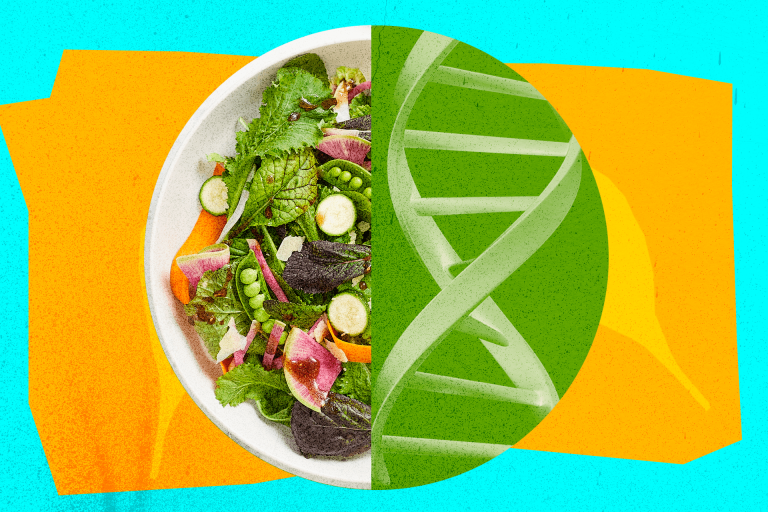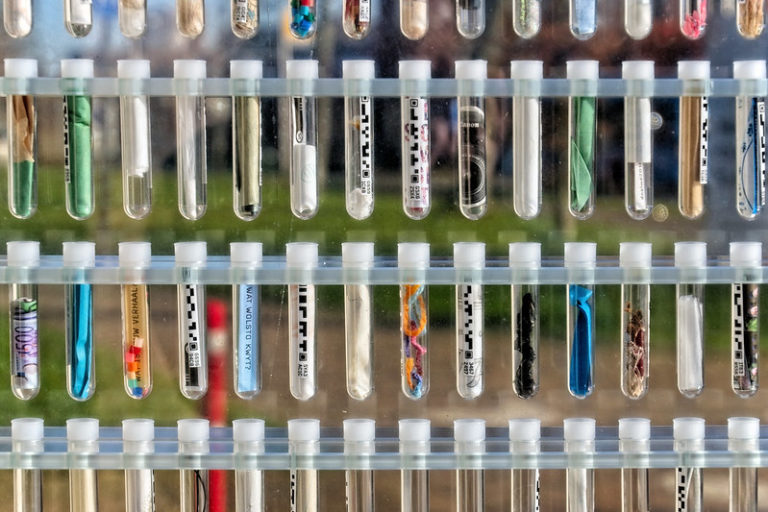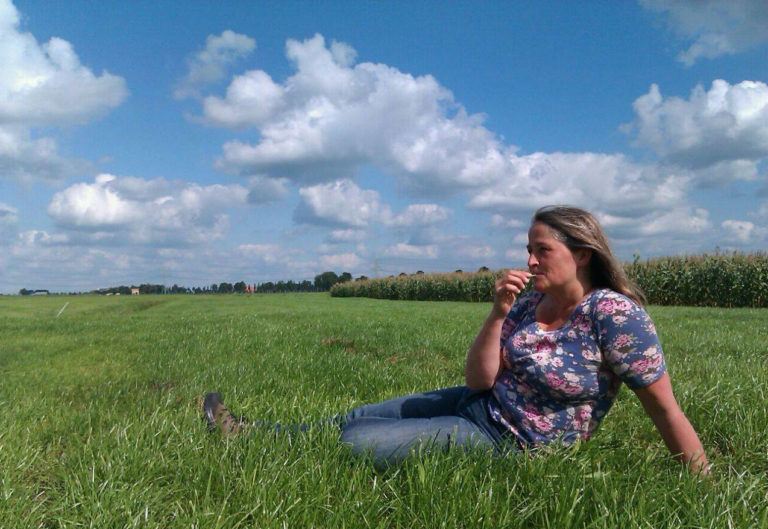GMO animals : accelerated growth with deleterious effects
More meat, milk, wool, etc. have always been some of the objectives of animal selection. For meat, two genetic modification strategies have been implemented : influencing the level of growth hormone, or blocking the gene responsible for the production of myostatin, a hormone that inhibits muscle growth. Research that is far from improving animal welfare…
In 1982, researchers inserted the rat growth hormone expression gene into a mouse genome and obtained giant mice [1]. In 1989, a company called AquaBounty [2], a subsidiary of Third Security, LLC, is a company specialising in the genetic modification of fish (salmon, tilapia)], began to genetically modify salmon to produce larger animals more quickly. The company inserted into the genome of farmed Atlantic salmon a double transgene consisting of a genetic sequence from Chinook salmon (the largest of the five salmon species), which increases hormone production, and a sequence from the American Ocean pout, a species that lives in colder waters than salmon. The combination is intended to produce growth hormone continuously, stimulating the appetite of the salmon, which then grows about twice as fast as conventionally farmed salmon.
Increasing the production of growth hormone
Currently, this transgenic salmon, named AquAdvantage, has been approved for commercialization in the United States (2015) and Canada (2016) [3], but its production remains very low (91 tons in 2021) [4]. Most attempts at transgenic salmon have been abandoned [5], and plans for other species with increased levels of growth hormone never came to commercial fruition [6].
Apart from a fairly widespread refusal by the major chain stores to market transgenic salmon, the primary cause of these failures is that altering the hormone level in the animals’ bodies can have many other effects : this hormone acts on several other traits (pleiotropic effect) [7]. For example, pigs with more muscle were also more sensitive to certain diseases, such as pneumonia and arthritis [8]. Research has also shown the relationship of genetic transformations with the age, breed or sex of the animal, thereby negating any claim to generalise these techniques to any breed and species, and de facto condemning breeders to revert to the many previous cross breedings.
A report by the Royal Society of Canada (2001) [9] also refers to these pleiotropic effects : « pleiotropy […] associated with the introduction of new genetic constructs is the rule rather than the exception in fish. This pleiotropy has manifested itself in changes in enzyme activity, gross anatomy, behaviour and, most likely, hormonal activity » [10]. Other studies document morphological abnormalities in transgenic coho salmon and damage on fish welfare, behaviour and ultimately survival capacity.
Similar physical consequences have been observed in transgenic carp [11] and in non-transgenic catfish injected with growth hormone [12]. Transgenesis can also affect the overall shape of transgenic fish, resulting in swimming problems. The Royal Society report explains that growth hormone production can alter the sensitivity of cells to other hormones, and can reduce the size of the pituitary gland in transgenic coho salmon by 50% to 83% [13]
Blocking myostatin production
Myostatin is a protein that limits muscle growth in animals. Since the beginning of the 2000s, experiments to modify the genetic sequence responsible for the expression of this protein by transgenesis have been carried out on cattle, sheep [14], salmon, mice. But none of these animals have been commercialised.
Research into animal modification therefore now involves the use of new tools, such as Talen [15] or Crispr/Cas9 [16], which does not address the problems associated with embryo transfers, and animal welfare issues. But again, the proposed genetic modification technique is proving complex to implement. Marc Vandeputte (Inrae)[M. Vandeputte] works at Inrae. He specialises in aquaculture and explains that “the number of fish modified by Crispr is currently very low, due to a real problem of technical skill for the injection of the Crispr/Cas9 complex [17]. This is also true for other nuclease-based genetic modification techniques as observed in the plant domain“ [18]. However, he stresses that « the system is vastly simpler and more efficient to implement and than conventional transgenesis, and the investment is significant in many countries. It therefore seems likely […] that important innovations may emerge in the medium term through these techniques ».
A large number of animal species (pigs [19], sheep [20], etc.) are currently being genetically modified worldwide, via various new genetic modification techniques to inactivate myostatin. In China, farm animals are being genetically modified for meat production, but also dogs are being genetically modified to improve their running in support of the police or the army [21]. Conversely, myostatin expression can be increased to produce dwarf animals, such as small pigs sold as pets. At present, failure rates are still quite high and there are many technical problems.
Fish were still the first animals modified by Crispr/Cas9, due to the costs of processing and development. In Argentina, in 2018, AquaBounty (again) was exempted from authorisation for a genetically modified tilapia, a farmed fish consumed worldwide. In Japan, at the end of 2021, the Regional Fish Institute (RFI) [22] was able to market a genetically modified red sea bream and tiger globe fish [23]. According to figures provided by AquaBounty, figures not published in a scientific journal, its tilapia « shows a significant improvement in fillet yield by 70%, an improvement in growth rate by 16% as well as an improvement in feed conversion rate by 14% ». And the sea bream would provide « 20% more meat » according to the Japanese startup’s claims. How reliable is this data ? It has long been known that results obtained on a ’station’ are very difficult to extrapolate to larger scales : the same is true under real farming conditions [24].
Less myostatin leads to perverse effects
Sheep and cattle have been engineered to inhibit the myostatin gene using the Talen tool [25] A calf resulting from such manipulation turned out to be « mosaic/chimeric » : some of its tissues carrying one of the mutations, other tissues carrying the wild-type allele or another mutation, a relatively common problem with genome « editing » techniques [26]. In practical terms, this means that the modified animal may have hypertrophied hind leg muscles while other muscles will remain normal.
Furthermore, modification by the Talen system implies the presence of unintended « collateral » mutations and epimutations, which could predispose the line to diseases, for example [27]. They result both from the presence of other more or less homologous sequences in the genome, which the Talen system will also cut, and from modifications due to the related techniques required by the Talen system (cell cultures in vitro, selection of modified cells…).
For example, with the « zinc finger nucleases » (ZFN) technique on pigs, Chinese researchers point out that « 20% of the mutant pigs had an extra thoracic vertebra ». For Yves Bertheau, “the effect of stress on isolated cells or multicellular clusters (i.e. in vitro vs. natural environments), on their subsequent development into an organism and on genetic reprogramming […] are currently well documented in animals. In vitro culture methods with injections are similar, if only in size, to the injections of « packages » of nucleic acids, proteins and/or ribonucleoprotein complexes of new genetic modification techniques. They induce profound disorders in the genomes and epigenomes, transcriptome perturbations… of the targeted cells and organisms, all transmissible disorders“ [28].
As with the variants of the « polled » dehorning gene [29], it was already possible to « play » with the myostatin gene without genetically modifying the animals, as evidenced by the « Bleu Blanc Belge » (BBB) breed of cow [30] The cows and bulls of this breed, which is very common in Belgium, appear to be deformed because of their prominent and protruding muscles. Some specimens produce 70% more meat than a « classic » bovine. In these so-called « double-muscled » (DM) cattle, muscle hypertrophy is a problem [31], even before any genetic modification : higher frequency of calving difficulties, reduced fertility, and ultimately calves with lower survival compared to other cattle [32].
The altered regulation of myostatin results in significant and accelerated muscle degeneration. « The extremely high carcass yield of DM animals coincides with a reduction in the size of most vital organs. As a result, DM animals may be more susceptible to respiratory diseases, lameness, nutritional stress, heat stress in addition to [the calving problems] already reported, resulting in reduced robustness ». Another study [33] reports, on the contrary, a problematic increase in the size of some internal organs, especially the tongue. The tongue of the modified piglets was longer and heavier than that of the control piglets. This phenomenon is also known in cattle of the BBB breed.
The inactivation of myostatin is also thought to result in faster and more intense fatigue. Myostatin gives skeletal muscle a high oxidative capacity. The modified animals are therefore likely to suffer more, to have more difficulty breathing and to have their well-being further degraded. Other adverse consequences have been shown : delayed puberty [34], reduced sperm count or motility [35], decreased testicular size [36], increased chances of tendon rupture [37], heart problems, etc. The economic objective of increasing meat production will therefore clearly be at the expense of the health and integrity of the animal. It could even be that, in the end, the numerous problems of discomfort of the animals will greatly reduce their economic interest, because of veterinary care and the necessary adjustments of the installations.
Eric Marois, a researcher at the French National Centre for Scientific Research (CNRS) [38], interviewed by Inf’OGM [39], recommends for ethical reasons and scientific rigour, and therefore to exclude the risk of unintentional collateral modifications, « the complete sequencing of the genome of the animal obtained and to compare its genome with that of the non-genetically modified parents ». Will the legislator take into account the scientific uncertainties by making compulsory this complete sequencing a posteriori of the animals obtained ? It should be noted, however, that no sequencing, however complete, will replace controlled trials over several generations in a confined environment, the only way to reveal other possible « problems » that have gone unnoticed by genetic tools alone.












